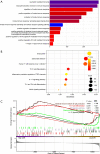Low expression of IL6R predicts poor prognosis for lung adenocarcinoma
- PMID: 34422969
- PMCID: PMC8339841
- DOI: 10.21037/atm-21-36
Low expression of IL6R predicts poor prognosis for lung adenocarcinoma
Abstract
Background: Interleukin 6 (IL6) is both a pleiotropic cytokine and an immune-related gene. Interleukin 6 receptor (IL6R) is the receptor for IL6. It may be closely connected to the development of lung cancer. This research aims to explore the prognostic value of IL6R and prevent overtreatment of patients with lung adenocarcinoma (LUAD).
Methods: In this study, the expression of IL6R in tumor tissues and surrounding tissues was first analyzed by immunohistochemistry in the Affiliated Hospital of Nantong University (NTU) cohort. Secondly, we downloaded information from The Cancer Genome Atlas (TCGA) for the TCGA cohort and used this information to explore the messenger RNA (mRNA) level of IL6R. We then used Kaplan-Meier survival analyses, univariate and multivariate Cox analyses, nomogram models, and decision curve analyses to assess the prognostic value of IL6R. In addition, we also analyzed immune cell infiltration and the signaling pathways related to IL6R through Gene Ontology (GO), Kyoto Encyclopedia of Genes and Genomes (KEGG), and Gene Set Enrichment Analysis (GSEA).
Results: Through the data analysis of the NTU cohort and the TCGA cohort, it was found that the expression of IL6R in normal tissues around the tumor was higher than that in tumor tissue, and was positively correlated with the overall survival (OS) of LUAD patients. Additionally, low expression of IL6R was found to be an independent predictor of poor prognosis among the patients in these two research cohorts. Next, using GO, KEGG, and GSEA analyses, we found that partially infiltrated tumor immune cells might be related to earlier staging and better prognosis of patients with LUAD. Finally, the study of the 3-5-year survival rate of LUAD patients through the nomogram showed that the expression of IL6R could improve the accuracy of prediction to prevent the overtreatment of some LUAD patients.
Conclusions: In summary, our study indicated that the low expression of IL6R was associated with poor prognosis among LUAD patients and that low expression of IL6R is a potential independent risk factor that could provide a basis for strengthening postoperative classification management of such patients.
Keywords: Interleukin 6 receptor (IL6R); Kyoto Encyclopedia of Genes and Genomes (KEGG); lung adenocarcinoma (LUAD); prognosis; risk factor.
2021 Annals of Translational Medicine. All rights reserved.
Conflict of interest statement
Conflicts of Interest: All authors have completed the ICMJE uniform disclosure form (available at https://dx.doi.org/10.21037/atm-21-36). The authors have no conflicts of interest to declare.
Figures









Similar articles
-
Construction of a Prognostic Immune-Related LncRNA Risk Model for Lung Adenocarcinoma.Front Cell Dev Biol. 2021 Mar 18;9:648806. doi: 10.3389/fcell.2021.648806. eCollection 2021. Front Cell Dev Biol. 2021. PMID: 33869203 Free PMC article.
-
High SERPINH1 expression predicts poor prognosis in lung adenocarcinoma.J Thorac Dis. 2022 Dec;14(12):4785-4802. doi: 10.21037/jtd-22-1518. J Thorac Dis. 2022. PMID: 36647484 Free PMC article.
-
Role of CENPL, DARS2, and PAICS in determining the prognosis of patients with lung adenocarcinoma.Transl Lung Cancer Res. 2024 Oct 31;13(10):2729-2745. doi: 10.21037/tlcr-24-696. Epub 2024 Oct 28. Transl Lung Cancer Res. 2024. PMID: 39507047 Free PMC article.
-
Development and validation of endoplasmic reticulum stress-related eight-gene signature for predicting the overall survival of lung adenocarcinoma.Transl Cancer Res. 2022 Jul;11(7):1909-1924. doi: 10.21037/tcr-22-106. Transl Cancer Res. 2022. PMID: 35966313 Free PMC article.
-
Construction of a prognostic model for lung adenocarcinoma based on bioinformatics analysis of metabolic genes.Transl Cancer Res. 2020 May;9(5):3518-3538. doi: 10.21037/tcr-20-1571. Transl Cancer Res. 2020. PMID: 35117717 Free PMC article.
Cited by
-
IL-6R expression is an independent prognostic factor in high-grade serous ovarian cancer.BJC Rep. 2025 Jul 8;3(1):49. doi: 10.1038/s44276-025-00139-0. BJC Rep. 2025. PMID: 40624140 Free PMC article.
-
Molecules promoting circulating clusters of cancer cells suggest novel therapeutic targets for treatment of metastatic cancers.Front Immunol. 2023 Mar 15;14:1099921. doi: 10.3389/fimmu.2023.1099921. eCollection 2023. Front Immunol. 2023. PMID: 37006265 Free PMC article. Review.
-
IL6 and IL6R as Prognostic Biomarkers in Colorectal Cancer.Biomolecules. 2024 Dec 19;14(12):1629. doi: 10.3390/biom14121629. Biomolecules. 2024. PMID: 39766336 Free PMC article.
-
Expression pattern and prognostic significance of aldehyde dehydrogenase 2 in lung adenocarcinoma as a potential predictor of immunotherapy efficacy.Cancer Innov. 2024 Dec 5;4(1):e149. doi: 10.1002/cai2.149. eCollection 2025 Feb. Cancer Innov. 2024. PMID: 39640071 Free PMC article.
-
Exploring the relationship between the interleukin family and lung adenocarcinoma through Mendelian randomization and RNA sequencing analysis.Discov Oncol. 2024 Sep 12;15(1):436. doi: 10.1007/s12672-024-01325-1. Discov Oncol. 2024. PMID: 39264458 Free PMC article.
References
LinkOut - more resources
Full Text Sources
Research Materials
